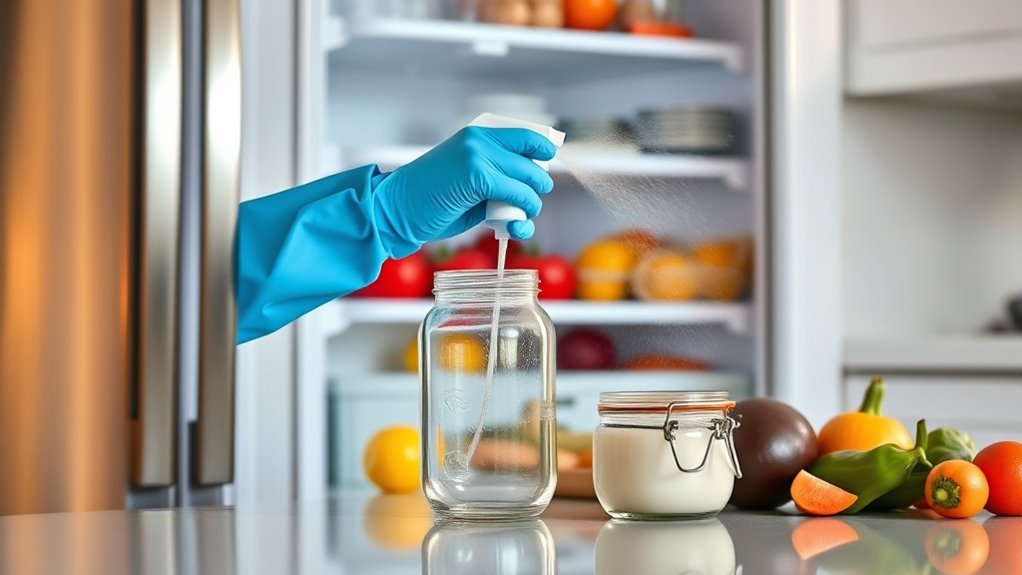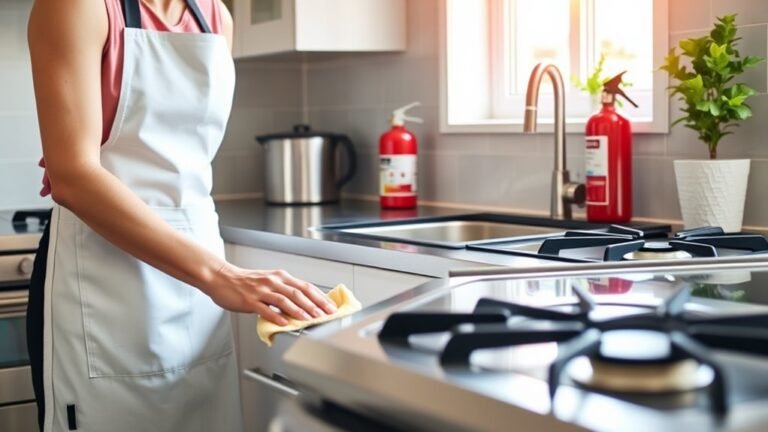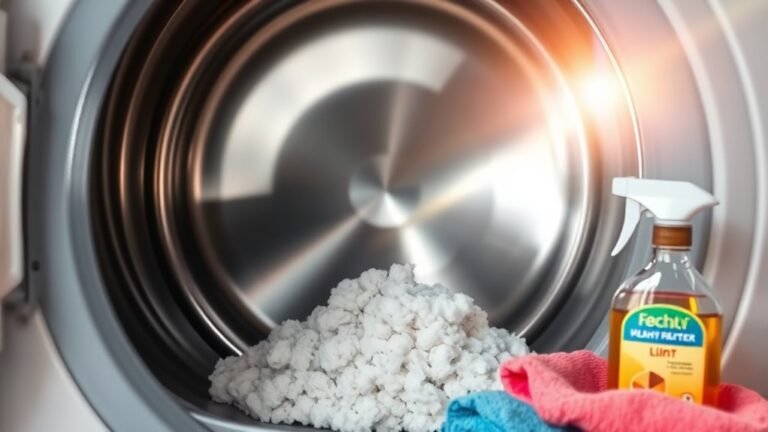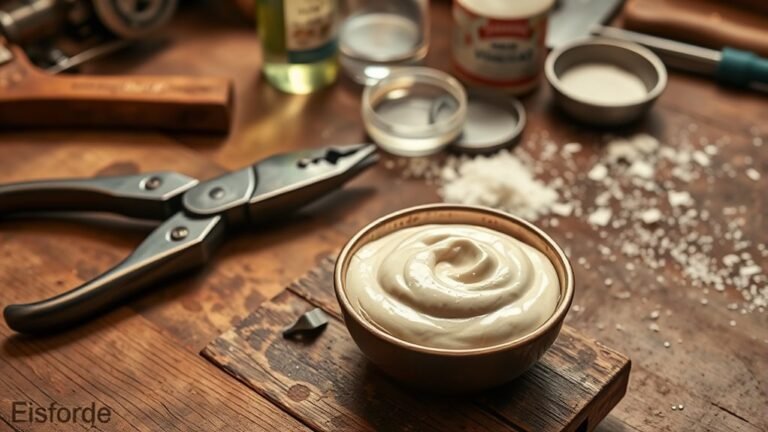Disinfecting High-Touch Areas in Refrigerator
You should regularly disinfect your refrigerator’s high-touch areas—like door handles, shelves, and seals—to minimize bacteria and keep food safe. Start by unplugging the fridge and removing all items. Clean surfaces with mild detergent and warm water before applying a food-safe disinfectant, allowing proper contact time. Rinse and air dry thoroughly. Focus on these spots weekly and maintain organized storage to prevent germs. Understanding these steps helps you maintain a cleaner, safer fridge environment.
Identifying High-Touch Areas in Your Refrigerator
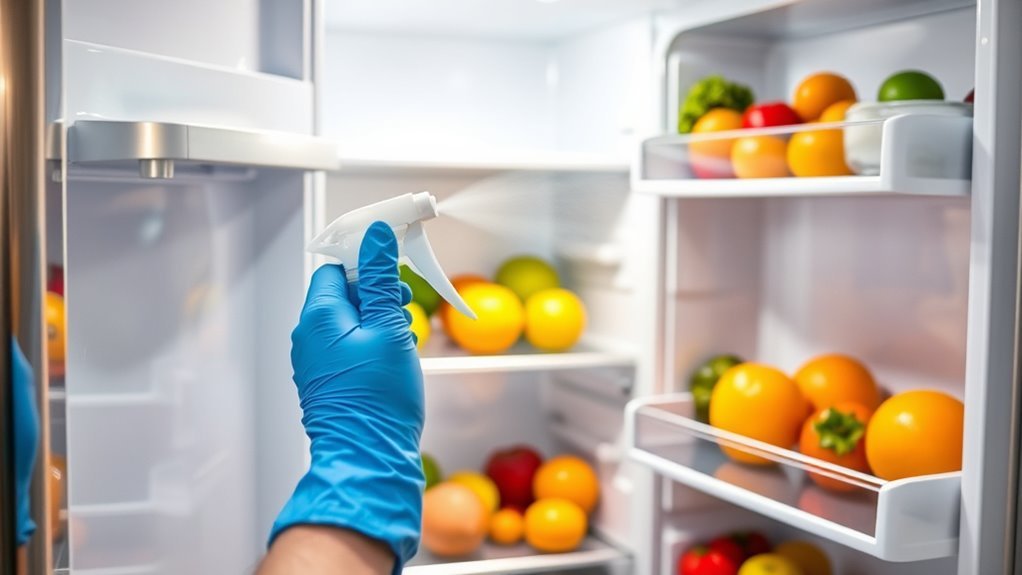
How do you know which parts of your refrigerator need the most attention when disinfecting? Focus primarily on high-touch areas where germs accumulate quickly. Door handles are the first critical spot—they’re constantly touched as you access your fridge, making them prime for bacterial transfer. Next, consider shelf surfaces. These areas often hold various food items, some prone to spills and contamination. Pay special attention to the edges and corners of shelves where residues can build up unnoticed. By methodically targeting these zones, you minimize microbial presence and protect your food’s safety. Regularly disinfecting door handles and shelf surfaces guarantees you maintain a clean environment without unnecessary effort, preserving your freedom to use your fridge confidently and hygienically every day.
Choosing Safe and Effective Disinfectants
While selecting disinfectants for your refrigerator, you need to balance effectiveness against germs with safety for your food environment. Opt for natural disinfectant options like diluted vinegar or hydrogen peroxide, which reduce chemical exposure without compromising cleanliness. When you choose chemical-based products, strictly follow chemical safety guidelines to avoid contamination and guarantee proper ventilation. Avoid bleach or ammonia near food surfaces unless thoroughly rinsed, as residues can be harmful. Prioritize disinfectants labeled safe for food contact surfaces, and never mix products, which can create toxic fumes. By being methodical and informed, you maintain a hygienic refrigerator while preserving your freedom to use safe, effective cleaning agents. This approach protects both your health and your food, guaranteeing a clean, safe environment without unnecessary risks.
Step-by-Step Guide to Cleaning and Disinfecting

Before you begin cleaning and disinfecting your refrigerator, it’s important to prepare by unplugging the appliance and removing all food items. Start by wiping down shelves, handles, and door seals with a damp cloth to remove loose dirt. Use effective cleaning techniques like a mixture of mild detergent and warm water for stubborn grime. After cleaning, apply your chosen disinfectant—preferably one safe for food-contact surfaces. Spray or wipe high-touch areas thoroughly, guaranteeing contact time as per product instructions. Avoid harsh chemicals that might damage surfaces or leave harmful residues. Finally, rinse surfaces with a clean, damp cloth and let them air dry completely before restocking. Following these steps guarantees your refrigerator stays hygienic and safe, giving you the freedom to store food without worry.
Frequency and Best Practices for Regular Maintenance
Regularly disinfecting high-touch areas in your refrigerator is essential to maintain hygiene and prevent contamination. Establish a consistent cleaning schedule, ideally once a week, to guarantee these surfaces remain free of germs. Incorporate this task into your broader maintenance routine, focusing on handles, door seals, and control panels where bacteria tend to accumulate. Use approved disinfectants safe for food-contact surfaces and follow contact time recommendations to maximize effectiveness. Avoid harsh chemicals that could damage materials or leave harmful residues. Document your cleaning schedule to track progress and adjust frequency based on usage intensity or household size. By adhering to a methodical maintenance routine, you’ll preserve both cleanliness and appliance longevity while enjoying the freedom of a safe, healthy kitchen environment.
Tips for Preventing Germ Buildup in the Future

To minimize germ buildup in your refrigerator, you’ll want to adopt proactive habits that reduce contamination risks. Start by using germ resistant materials for shelves and containers, which can markedly lower microbial growth. Prioritize storage organization by grouping similar items together and using sealed containers to prevent cross-contamination. Regularly wipe down surfaces with appropriate disinfectants to maintain cleanliness. Avoid overcrowding to guarantee proper air circulation, which helps inhibit bacteria proliferation. Additionally, immediately clean spills and remove expired food to reduce breeding grounds for germs. By integrating these strategies into your routine, you maintain a hygienic environment, prolong food freshness, and enjoy the freedom of a safe, well-organized refrigerator without constant worry about contamination.
Frequently Asked Questions
Can Disinfectants Damage Refrigerator Seals or Surfaces?
Yes, some disinfectants can damage refrigerator seals or surfaces if they’re too harsh or contain bleach or ammonia. For effective refrigerator maintenance, you should choose gentle, non-abrasive cleaners to guarantee surface protection and avoid degrading rubber seals. Always test a small area first and follow manufacturer recommendations. Taking these precautions helps you keep your fridge clean without compromising its function or lifespan, giving you the freedom to maintain it safely.
Is It Safe to Use Bleach Inside a Refrigerator?
When considering bleach safety, you should know it’s generally not recommended to use bleach directly inside your refrigerator. While bleach is effective for refrigerator hygiene, it can leave harmful residues and strong odors that might contaminate your food. Instead, use a mild detergent or a vinegar solution to clean. If you do use bleach, dilute it heavily, rinse thoroughly, and allow the fridge to air out completely before storing food to keep things safe.
How Long Should the Refrigerator Remain off During Disinfection?
When it comes to refrigerator maintenance, you want to kill two birds with one stone: clean thoroughly and avoid spoilage. Keep your fridge off for about 15-30 minutes during disinfection to allow cleaning agents to work effectively without damaging components. Remember, the disinfection frequency depends on usage—monthly is a good rule of thumb. This way, you maintain freshness and freedom from germs without compromising your food’s quality or your appliance’s lifespan.
Can UV Light Be Used to Disinfect Refrigerator Interiors?
You can use UV sanitation to disinfect refrigerator interiors, but you should know its light effectiveness depends on direct exposure. UV light kills bacteria and viruses on surfaces it reaches, but shadows or dirt can reduce its power. Make certain to clean surfaces first and use a UV device designed for small spaces. While UV sanitation is effective, it’s best combined with regular cleaning to guarantee your fridge stays hygienic and safe.
Are There Eco-Friendly Disinfectant Options for Refrigerators?
Oh sure, you could keep bathing your fridge in harsh chemicals like a mad scientist, or you could embrace the freedom of natural cleaners and green products. These eco-friendly options, like vinegar, baking soda, and lemon juice, effectively disinfect without trapping you in a toxic cloud. You just need to apply methodically—wipe surfaces with a vinegar solution, rinse, then dry. It’s simple, safe, and lets you keep your fridge fresh without environmental guilt.
